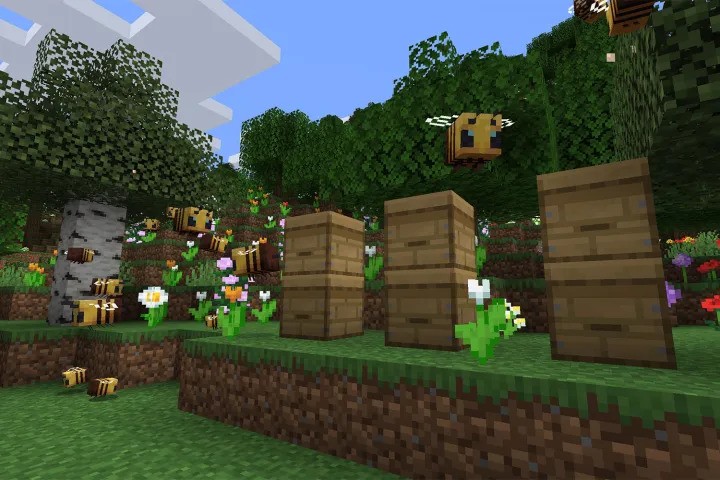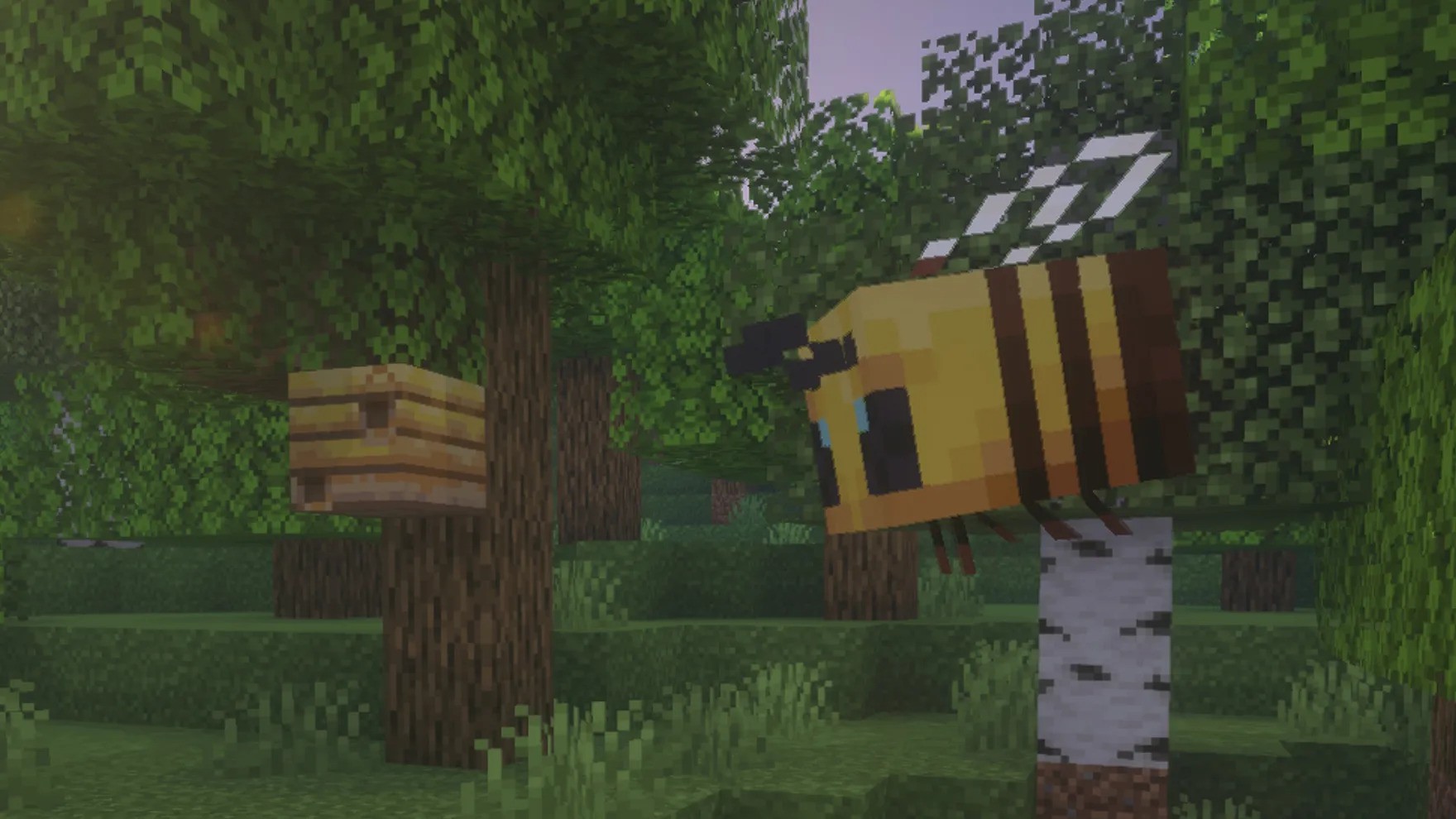Embarking on the adventure to collect honeycomb in Minecraft leads you to the intricate dance of nature within the game, highlighted by bee nests and hives nestled in diverse biomes. Understanding how to get honeycomb in Minecraft without the hassle uncovers a realm of crafting potential, making it essential for enriching your gameplay.
This article guides you through the process of locating bee nests and beehives, the safe method to harvest honeycomb using shears, and the creative ventures honeycomb allows in Minecraft. Whether you’re waxing copper blocks to crafting candles, we’ll provide the insights needed to elevate your Minecraft experience with honeycomb.
Finding Bee Nests and Beehives
To successfully locate bee nests and beehives in Minecraft, understanding the specific biomes where these structures naturally spawn is crucial. Bee nests are predominantly found in three main biomes: Plains, Sunflower Plains, and Flower Forest. Each biome offers varying probabilities of encountering bees and their homes.
Biome Specifics and Bee Nest Locating Strategies
- Plains Biome: This is the most common biome where bee nests can appear. Although it has fewer trees, which might seem like a disadvantage, the openness makes it easier to spot bee nests.
- Sunflower Plains Biome: Although rarer, this biome has a higher likelihood of spawning bees due to the abundance of flowers and sunflowers, which attract bees.
- Flower Forest Biome: This biome is quite rare but is your best bet for finding bee nests due to the high density of trees and flowers. The lush environment increases the chances of bee activity.
Tips for Maximizing Bee Nest Spawns
- Explore New Areas: Bee nests only generate during the world generation phase. To increase your chances of finding them, explore new chunks of the world that haven’t been loaded before.
- Planting Saplings: To encourage bee nest generation, plant birch and oak saplings in open areas. An efficient pattern involves placing saplings with two air gaps between them, allowing space for bee nests to potentially grow on all four sides of each tree.
- Use of Flowers: Bees are attracted to flowers, which they use for breeding. Planting flowers near your saplings not only attracts bees but also aids in pollination, which is necessary for the production of honey in the nests.
Understanding these strategies and biome characteristics will guide you in effectively finding bee nests and beehives, enhancing your Minecraft experience by enabling the collection of honeycomb and the observation of bee behavior in their natural habitat.
Safely Harvesting Honeycomb
To successfully harvest honeycomb in Minecraft without disturbing the bees, follow these detailed steps:
Step-by-Step Instructions for Harvesting Honeycomb
- Crafting Shears: First, craft a set of shears by placing two iron ingots in a diagonal pattern in any two slots of a crafting table (3×3 grid).
- Check Honey Level: Ensure the bee nest or beehive has reached honey level 5, which is indicated by honey visibly dripping from the hive or nest.
- Placing the Campfire: Before harvesting, place a lit campfire directly underneath the nest or hive. This step is crucial as it calms the bees, preventing them from becoming aggressive during the harvesting process.

Protecting the Bees
- Java Edition: Place a carpet over the campfire to prevent bees from getting hurt by the fire.
- Bedrock Edition: Dig a hole, place the campfire inside, and surround it with a fence. This setup ensures bees do not fly into the campfire while still being calmed by the smoke.
Harvesting Process
- Using Shears: Once the hive or nest is full (honey level 5), use the shears on it to collect the honeycomb. Each successful use of shears on a full hive or nest yields three units of honeycomb.
- Bee Behavior: Remember, bees are neutral and won’t attack unless provoked. The smoke from the campfire underneath the hive keeps them calm during the harvesting process.
By following these steps, you can efficiently and safely collect honeycomb in Minecraft, ensuring both your safety and the well-being of the bees.
Crafting with Honeycomb
Beehives and Honeycomb Blocks
- Crafting Beehives: To create a beehive, arrange six wooden planks (any type) across the top and bottom rows of your crafting table. Place three honeycombs in the middle row. This crafted beehive functions just like the naturally occurring bee nests, allowing you to farm honey and honeycomb efficiently.
- Making Honeycomb Blocks: For decorative purposes, place four honeycombs in a square pattern within the crafting grid. Honeycomb blocks serve as excellent decorative elements due to their unique texture and are purely aesthetic.
Crafting Candles and Waxed Copper
- Creating Candles: Candles are not only functional as light sources but also add a charming aesthetic to your builds. To craft a candle, place one string directly below a honeycomb in the crafting grid. You can dye candles by adding a dye next to them in the crafting setup.
- Waxing Copper Items: To prevent copper items from oxidizing and losing their shiny appearance, apply honeycomb directly to any copper block, slab, or stair. This process retains the aesthetic quality of copper items throughout your gameplay.
Utilizing Honeycomb in Various Crafts
- Comprehensive Crafting Uses: Honeycomb is versatile, extending beyond basic crafting. It can be used to wax various copper-related blocks, preventing them from oxidizing. Additionally, honeycomb plays a role in crafting beehives, which are crucial for beekeeping in Minecraft.
- Decorative and Functional Uses: Whether you’re looking to decorate your space with honeycomb blocks or light it up with candles, or even maintain the pristine condition of your copper structures, honeycomb provides both functional and decorative uses in the game.
Conclusion
Throughout this guide, we have explored the intricacies of collecting honeycomb in Minecraft, a task that enriches the gaming experience by providing a plethora of crafting opportunities. From locating bee nests and hives in various biomes to the careful process of harvesting honeycomb without distressing the bees, every step has been detailed to ensure players can maximize their crafting potential. By adhering to the guidance on biome exploration, the strategic placement of flowers and saplings, and the safe collection methods, players are well-equipped to navigate the world of Minecraft with an added goal of honeycomb collection.
The significance of honeycomb in Minecraft extends beyond mere collection; it opens the door to creative ventures such as crafting beehives, honeycomb blocks, candles, and waxing copper items. This guide not only aims to facilitate the efficient gathering of this valuable resource but also to inspire the utilization of honeycomb in various decorative and functional aspects of the game. As players delve into the enriching experience of beekeeping and crafting with honeycomb, they contribute to a vibrant ecosystem within Minecraft, echoing the game’s endless possibilities for creativity and exploration.
FAQs
1. What’s the simplest method to obtain honeycomb in Minecraft?
To easily get a honeycomb in Minecraft, locate a bee nest or hive and wait until it reaches honey level 5. Then, use shears to carefully harvest the honeycomb.
2. How can I harvest honeycomb without upsetting the bees?
To harvest honeycomb without provoking the bees, light a fire or place a campfire within five blocks directly below the nest. The smoke helps to calm the bees, preventing them from becoming aggressive.
3. What steps should I take to collect honeycomb without being attacked by bees?
Ensure you use a campfire placed below the bee nest or hive. The smoke from the campfire will pacify the bees, allowing you to collect honeycomb safely without any attacks.
4. How can I harvest honey peacefully in Minecraft?
To harvest honey or honeycomb peacefully, position a campfire beneath the bee nest or hive. It’s the smoke from the campfire that calms the bees, not the fire itself. Be cautious as bees can get harmed if they come too close to the fire.